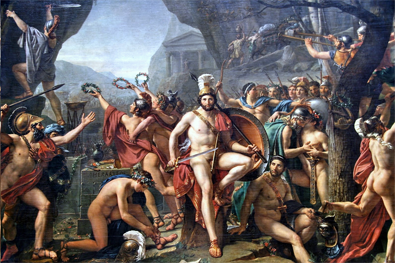The Greek-Persian wars
In the early 5th century BCE, the Persians twice attempted to conquer Greeks. The Greek city-states, especially Athens and Sparta, were always squabbling with each other but they united against the Persians. Though hugely outnumbered, the Greeks finally saw the Persians off.
Hoplites on the run
The Greeks fought on foot in formations called phalanxes, of eight to 50 ranks (rows). With their shields locked tightly together to form a protective wall and the spears of those in front pointing towards the enemy, the phalanx advanced at a run.
Quick-moving Persian
The Persian had greater mobility on the battlefield thanks to their lighter equipment. This archer is wearing a soft felt cap and mail coat in contrast to the heavy bronze helmets and body armour of the Greeks. The Persians armour of the Greeks. The Persians fought at a distance, using their archers to break up the advancing enemy and bringing in cavalry to ride them down.
"Come and get them!"
Leonida's answer to Xerxes when he ordered the Spartans to lay down their weapons at Thermopylae
ــــــــــــــــــ
Who's who
Xerxes
Darius I's son, Xerxes, became king of Persia in 486 BCE. Six Years later he invaded Greece in revenge for his father's defeat at Marathon.
Artemisia
Queen of Halicarnassus (a city on the site of Bodrum, Turkey), Artemisia Sent live ships to join Xerxes' fleet.
She took part in the Battle of Salamis.
Leonidas
Known as Leonidas the Brave, this king of Sparta led an elite force of 300 Spartans on a suicide mission at Thermopylae.
ــــــــــــــــــ
The Battle of Thermopylae
This 19th-century painting shows the heroic Spartan king Leonidas. The Greeks met Xerxes' invasion force at a narrow mountain pass.

Knowing defeat was inevitable, Leonidas sent the rest of the Greeks away while he and his Spartan force delayed the Persian advance. They all died.
ــــــــــــــــــ
Marathon man
Pheidippides was a Greek messenger who ran all the way from Athens To ask the Spartans for help before the Battle of Marathon but they refused to come. Another story says that he ran 40 km (35 miles) from Marathon to Athens to announce the Greek victory - the origin of the modern marathon.
...
499 BCE
During the reign of Darius I, the Ionian city - states revolt against Persia. Athens came to their aid.
ــــــــــــــــــ
Major battles
490 BC Marathon
This battle was fought on the plain of Marathon, north of Athens. Led by the Athenian general Miltiades, a much smaller Greek army defended Darius I;s invasion force.
...
Forces
Greeks: 7,000, including 300 elite Spartan troops
Persians: up to 250,000, including 10,000 "Immortals" (elite infantry)
ــــــــــــــــــ
480 BCE Salamis
Themistocles, commanding the Athenian fleet, lured the Persian fleet into an ambush off the island of Salamis, king Xerxes watched from the shore as his much larger fleet was rammed and destroyed.
...
Forces
Greeks: 378 ships
Persians: 800 ships
ــــــــــــــــــ
479 BCE Plataea
The Greek and Persian armies clashed on Theban territory. A surprise Spartan phalanx charge made the Persian army turn and flee, giving the Greeks final victory.
...
Force
Greeks: 40,000
Persians: 120,000 (including Greek allies)
ــــــــــــــــــ

Key events
547 BCE
Cyrus the Great, king of Persia, conquered the Ionian city-states of Anatolia
499 BCE
During the reign of Darius I, the Ionian city - states revolt against Persia. Athens came to their aid.
490 BCE
Darius I sent a huge army to punish Athens. The Athenians defeated the persians at Marathon
480 BCE
The Persians reached Athens and burned the city.
479 BCE
The Persians were defeated at Plataea and never invaded Greece again.
477 BCE
Athens headed an anti-Persian alliance of city-states. Sparta refused to join.
440 Bce
The history of the Greek and Persian wars was written down by Herodotus, the ancient Greek historian.
History Year by Year/Peter Chrisp, Joe Fullman, Susan Kennedy